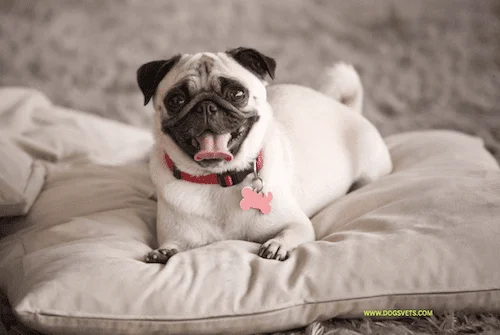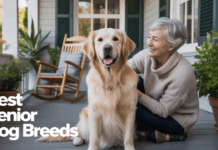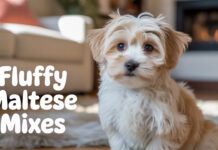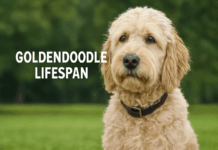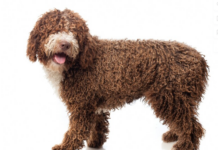Last Updated on April 11, 2023 by Dogs Vets
Discover the Top Lazy Dog Breeds That Will Adapt Perfectly to Your Relaxing Lifestyle
Are you a laid-back person searching for the perfect canine companion to match your chill lifestyle? Look no further! This comprehensive guide to lazy dog breeds will help you find your ideal low-energy pet.
From the majestic Great Dane to the lovable English Bulldog, there’s a breed for everyone seeking a calm and easygoing furry friend.
Read on to discover the top 15 lazy dog breeds that will make the perfect addition to your relaxed home.
#1. Great Dane

The Great Dane, often referred to as the “Apollo of dogs,” is a giant breed known for its imposing size, majestic appearance, and gentle temperament.
With a history that dates back to ancient times, Great Danes were initially bred to hunt large game and protect estates. Today, these gentle giants are cherished as loving and affectionate companions, well-suited for families and individuals alike.
Despite their enormous size, Great Danes are known for their kind and gentle nature, making them excellent companions for children and other pets.
Their calm and easygoing temperament allows them to adapt well to various living situations, and they form strong bonds with their families.
Great Danes are protective of their loved ones, making them effective watchdogs, but their friendly nature ensures they are approachable and welcoming to new people and animals.
As a giant breed, Great Danes do require regular exercise to maintain their health and happiness.
Daily walks and moderate play sessions are typically sufficient to keep them fit and content.
However, it is essential to monitor their exercise, especially during their growth phase, to avoid placing excessive strain on their joints and bones.
Grooming a Great Dane is relatively low-maintenance, as their short coats require minimal brushing. However, it’s essential to keep their nails trimmed and check their ears regularly to ensure good overall hygiene.
This breed can be prone to certain health issues, such as hip dysplasia, heart conditions, and bloat, so regular veterinary check-ups are crucial for maintaining their health.
Training a Great Dane can be a rewarding experience, as they are intelligent and eager to please. Early training and socialization are essential to ensure they grow up to be well-behaved and obedient companions.
Consistent, positive reinforcement training methods will yield the best results, and establishing a strong bond between you and your dog from an early age is crucial.
#2. Basset Hound

The Basset Hound, with its droopy ears, mournful eyes, and charming personality, is a medium-sized breed known for its exceptional scent-tracking abilities.
Originally bred in France for hunting small game, Basset Hounds have evolved into loving and affectionate companions, well-suited for families and individuals seeking a low-energy and friendly pet.
Basset Hounds are known for their gentle and easygoing nature, making them excellent companions for children and other pets. Their calm temperament allows them to adapt well to various living situations, and they form strong bonds with their families.
Basset Hounds are friendly and welcoming to new people and animals, making them an approachable and sociable breed.
As a scent hound, Basset Hounds do require regular exercise to maintain their health and happiness. Daily walks and moderate play sessions, preferably in a securely fenced area, are typically sufficient to keep them fit and content.
However, it is essential to monitor their exercise to avoid placing excessive strain on their joints and bones, especially given their unique body structure.
Grooming a Basset Hound can be relatively low-maintenance, as their short coats require minimal brushing. However, it’s essential to clean their long ears regularly to prevent infections and ensure good overall hygiene.
Basset Hounds can be prone to certain health issues, such as ear infections, hip dysplasia, and obesity, so regular veterinary check-ups are crucial for maintaining their health.
Training a Basset Hound can be both rewarding and challenging due to their independent nature and occasional stubbornness.
Early training and socialization are essential to ensure they grow up to be well-behaved and obedient companions. Consistent, positive reinforcement training methods will yield the best results, and establishing a strong bond between you and your dog from an early age is crucial.
#3. English Bulldog
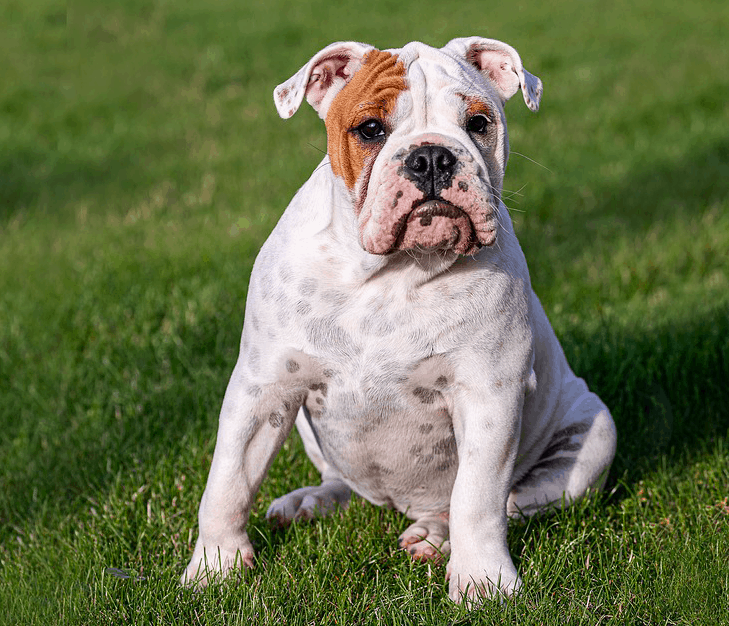
The English Bulldog, with its iconic wrinkled face, muscular build, and lovable personality, is a medium-sized breed that has been cherished as a companion for centuries.
Originally bred for bull-baiting, English Bulldogs have since become beloved family pets, known for their loyalty and affectionate nature.
English Bulldogs are known for their friendly and easygoing nature, making them excellent companions for children and other pets. Their adaptable temperament allows them to thrive in various living situations, from city apartments to spacious country homes.
English Bulldogs form strong bonds with their families, and their loving personalities make them delightful pets for those seeking a loyal and affectionate companion.
As a brachycephalic breed, English Bulldogs do not require intense exercise, making them well-suited for a more relaxed lifestyle.
Daily walks and moderate play sessions are typically sufficient to keep them fit and content. However, it is essential to monitor their exercise and avoid overheating due to their flat faces and potential breathing difficulties.
Grooming an English Bulldog can be relatively low-maintenance, as their short, smooth coats require minimal brushing. However, it’s essential to clean their facial wrinkles regularly to prevent infections and ensure good overall hygiene.
English Bulldogs can be prone to certain health issues, such as breathing difficulties, hip dysplasia, and skin allergies, so regular veterinary check-ups are crucial for maintaining their health.
Training an English Bulldog can be a rewarding experience, as they are intelligent and eager to please. Early training and socialization are essential to ensure they grow up to be well-behaved and obedient companions.
Consistent, positive reinforcement training methods will yield the best results, and establishing a strong bond between you and your dog from an early age is crucial.
#4. Cavalier King Charles Spaniel
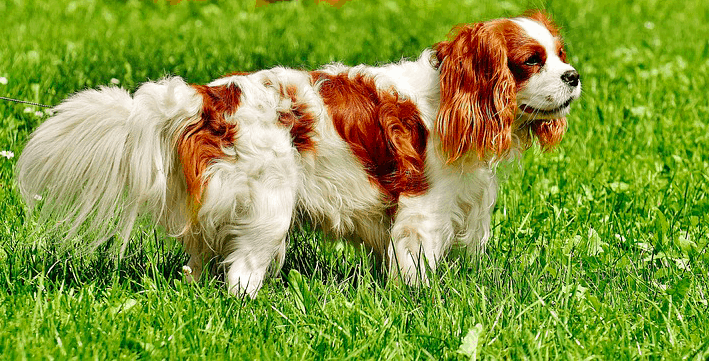
The Cavalier King Charles Spaniel, with its elegant appearance and affectionate nature, is a small breed that has been cherished as a companion for centuries.
Originating in England, these dogs were favored by British royalty and have been immortalized in countless works of art.
Today, Cavalier King Charles Spaniels continue to be adored by families and individuals seeking a loving and sociable pet.
Cavalier King Charles Spaniels are known for their friendly and gentle nature, making them excellent companions for children and other pets. Their adaptable temperament allows them to thrive in various living situations, from city apartments to spacious country homes.
Cavaliers form strong bonds with their families, and their loving personalities make them delightful pets for those seeking a loyal and affectionate companion.
As an energetic and playful breed, Cavalier King Charles Spaniels require regular exercise to maintain their health and happiness.
Daily walks and moderate play sessions are typically sufficient to keep them fit and content. These dogs also excel in dog sports such as agility, obedience, and rally, providing a fun and engaging way to bond with your pet while keeping them active.
Grooming a Cavalier King Charles Spaniel can be relatively low-maintenance, as their medium-length coats require only occasional brushing to prevent matting and shedding.
However, it’s essential to trim their nails and check their ears regularly to ensure good overall hygiene. Cavaliers can be prone to certain health issues, such as heart conditions, hip dysplasia, and eye problems, so regular veterinary check-ups are crucial for maintaining their health.
Training a Cavalier King Charles Spaniel can be a rewarding experience, as they are intelligent and eager to please.
Early training and socialization are essential to ensure they grow up to be well-behaved and obedient companions.
Consistent, positive reinforcement training methods will yield the best results, and establishing a strong bond between you and your dog from an early age is crucial.
#5. Shih Tzu
The Shih Tzu, with its flowing coat, sweet expression, and charming personality, is a small breed that has been treasured as a companion for centuries.
Originating from Tibet, Shih Tzus were bred as lap dogs for Chinese royalty and have been immortalized in various works of art. Today, these affectionate and sociable dogs are cherished by families and individuals seeking a loving and low-energy pet.
Shih Tzus are known for their friendly and outgoing nature, making them excellent companions for children and other pets. Their adaptable temperament allows them to thrive in various living situations, including city apartments and suburban homes.
Shih Tzus form strong bonds with their families, and their loving personalities make them delightful pets for those seeking a loyal and affectionate companion.
As a small and relatively low-energy breed, Shih Tzus do not require intense exercise, making them well-suited for a more relaxed lifestyle.
Daily walks and moderate play sessions are typically sufficient to keep them fit and content. However, it is essential to monitor their exercise and avoid overexertion, as their flat faces and potential breathing difficulties can make them prone to overheating.
Grooming a Shih Tzu can be quite involved, as their long, flowing coats require regular brushing to prevent matting and shedding.
Additionally, it’s essential to trim their nails, check their ears, and clean their facial wrinkles regularly to ensure good overall hygiene.
Shih Tzus can be prone to certain health issues, such as hip dysplasia, eye problems, and allergies, so regular veterinary check-ups are crucial for maintaining their health.
Training a Shih Tzu can be a rewarding experience, as they are intelligent and eager to please. Early training and socialization are essential to ensure they grow up to be well-behaved and obedient companions.
Consistent, positive reinforcement training methods will yield the best results, and establishing a strong bond between you and your dog from an early age is crucial.
#6. Chow Chow
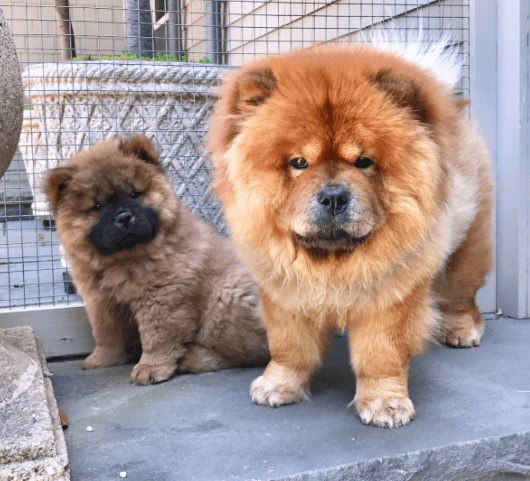
The Chow Chow, with its distinctive fluffy coat, lion-like mane, and unique blue-black tongue, is a medium-sized breed that has captivated dog lovers for centuries.
Originating in ancient China, Chow Chows were used as working dogs, guarding temples and homes, and even assisting in hunting. Today, these dignified and independent dogs are cherished by families and individuals seeking a loyal and protective companion.
Chow Chows are known for their aloof and reserved nature, making them better-suited for experienced dog owners who can appreciate and respect their unique temperament.
They form strong bonds with their families and can be fiercely protective, making them effective watchdogs. Chow Chows may not be overly affectionate, but their loyalty and devotion to their families are unwavering.
As a moderately active breed, Chow Chows require regular exercise to maintain their health and happiness. Daily walks and moderate play sessions are typically sufficient to keep them fit and content.
However, it is essential to monitor their exercise, especially during hot weather, as their thick coats can make them prone to overheating.
Grooming a Chow Chow can be quite involved, as their thick double coats require regular brushing to prevent matting and shedding. Additionally, it’s essential to trim their nails and check their ears regularly to ensure good overall hygiene.
Chow Chows can be prone to certain health issues, such as hip dysplasia, elbow dysplasia, and eye problems, so regular veterinary check-ups are crucial for maintaining their health.
Training a Chow Chow can be both rewarding and challenging due to their independent nature and occasional stubbornness.
Early training and socialization are essential to ensure they grow up to be well-behaved and obedient companions.
Consistent, positive reinforcement training methods will yield the best results, and establishing a strong bond between you and your dog from an early age is crucial.
#7. Pug
The Pug, with its wrinkled face, expressive eyes, and charming personality, is a small breed that has been adored as a companion for centuries.
Originating from China, Pugs were favored by Chinese emperors and later became popular among European royalty.
Today, Pugs continue to be cherished by families and individuals seeking a loving, sociable, and low-energy pet.
Pugs are known for their friendly and gentle nature, making them excellent companions for children and other pets. Their adaptable temperament allows them to thrive in various living situations, including city apartments and suburban homes.
Pugs form strong bonds with their families, and their loving personalities make them delightful pets for those seeking a loyal and affectionate companion.
As a brachycephalic breed, Pugs do not require intense exercise, making them well-suited for a more relaxed lifestyle. Daily walks and moderate play sessions are typically sufficient to keep them fit and content.
However, it is essential to monitor their exercise and avoid overheating due to their flat faces and potential breathing difficulties.
Grooming a Pug can be relatively low-maintenance, as their short coats require minimal brushing. However, it’s essential to clean their facial wrinkles regularly to prevent infections and ensure good overall hygiene.
Pugs can be prone to certain health issues, such as breathing difficulties, hip dysplasia, and eye problems, so regular veterinary check-ups are crucial for maintaining their health.
Training a Pug can be a rewarding experience, as they are intelligent and eager to please. Early training and socialization are essential to ensure they grow up to be well-behaved and obedient companions.
Consistent, positive reinforcement training methods will yield the best results, and establishing a strong bond between you and your dog from an early age is crucial.
#8. French Bulldog

The French Bulldog, affectionately known as the “Frenchie,” is a small breed characterized by its bat-like ears, muscular build, and charming personality.
Originally bred in England as a miniature version of the English Bulldog, the French Bulldog gained popularity in France, where it was further developed into the beloved companion we know today.
These adorable and affectionate dogs make perfect pets for families and individuals seeking a low-energy and sociable companion.
French Bulldogs are known for their friendly and easygoing nature, making them excellent companions for children and other pets. Their adaptable temperament allows them to thrive in various living situations, including city apartments and suburban homes.
Frenchies form strong bonds with their families, and their loving personalities make them delightful pets for those seeking a loyal and affectionate companion.
As a brachycephalic breed, French Bulldogs do not require intense exercise, making them well-suited for a more relaxed lifestyle.
Daily walks and moderate play sessions are typically sufficient to keep them fit and content. However, it is essential to monitor their exercise and avoid overheating due to their flat faces and potential breathing difficulties.
Grooming a French Bulldog is relatively low-maintenance, as their short coats require minimal brushing. However, it’s essential to clean their facial wrinkles regularly to prevent infections and ensure good overall hygiene.
French Bulldogs can be prone to certain health issues, such as breathing difficulties, hip dysplasia, and allergies, so regular veterinary check-ups are crucial for maintaining their health.
Training a French Bulldog can be a rewarding experience, as they are intelligent and eager to please.
Early training and socialization are essential to ensure they grow up to be well-behaved and obedient companions.
Consistent, positive reinforcement training methods will yield the best results, and establishing a strong bond between you and your dog from an early age is crucial.
#9. Saint Bernard
The Saint Bernard is a giant breed known for its gentle temperament, incredible strength, and historical role as a mountain rescue dog.
Originating in the Swiss Alps, Saint Bernards were initially bred by monks to rescue travelers who became lost or injured in the treacherous mountain passes.
Today, these gentle giants are cherished as loving and affectionate companions, well-suited for families and individuals alike.
Despite their enormous size, Saint Bernards are known for their kind and gentle nature, making them excellent companions for children and other pets. Their calm and easygoing temperament allows them to adapt well to various living situations, and they form strong bonds with their families.
Saint Bernards are protective of their loved ones, making them effective watchdogs, but their friendly nature ensures they are approachable and welcoming to new people and animals.
As a giant breed, Saint Bernards do require regular exercise to maintain their health and happiness. Daily walks and moderate play sessions are typically sufficient to keep them fit and content. However, it is essential to monitor their exercise, especially during their growth phase, to avoid placing excessive strain on their joints and bones.
Grooming a Saint Bernard can be quite involved, as their thick double coats require regular brushing to prevent matting and shedding.
Additionally, it’s essential to trim their nails and check their ears regularly to ensure good overall hygiene. This breed can be prone to certain health issues, such as hip dysplasia, elbow dysplasia, and bloat, so regular veterinary check-ups are crucial for maintaining their health.
Training a Saint Bernard can be a rewarding experience, as they are intelligent and eager to please.
Early training and socialization are essential to ensure they grow up to be well-behaved and obedient companions. Consistent, positive reinforcement training methods will yield the best results, and establishing a strong bond between you and your dog from an early age is crucial.
#10. Greyhound

The Greyhound, known for its sleek and elegant appearance, is a large breed with a rich history dating back thousands of years.
Renowned for their incredible speed, Greyhounds were initially bred for hunting and catching small animals, eventually evolving into the world of dog racing.
Despite their reputation as racing dogs, Greyhounds are surprisingly calm and affectionate companions, well-suited for families or individuals seeking a low-energy and loving pet.
While Greyhounds are indeed fast runners, they are often referred to as “45-mph couch potatoes” due to their relaxed and laid-back nature when indoors.
Greyhounds are affectionate and gentle dogs that form strong bonds with their families. They are typically good with children and other pets, making them an excellent addition to a household with existing furry family members.
Greyhounds do require regular exercise to maintain their health and happiness. However, their exercise needs can be met with a daily walk and a few short, controlled sprinting sessions in a securely fenced area.
Contrary to popular belief, they do not require excessive amounts of exercise, and they are more than content to spend much of their day lounging around the house.
Grooming a Greyhound is relatively low-maintenance, as their short coats require minimal brushing. However, it’s essential to keep their nails trimmed and check their ears regularly to ensure good overall hygiene.
This breed can be prone to certain health issues, such as hip dysplasia, heart conditions, and bloat, so regular veterinary check-ups are crucial for maintaining their health.
Training a Greyhound can be a rewarding experience, as they are intelligent and eager to please. Early training and socialization are essential to ensure they grow up to be well-behaved and obedient companions.
Consistent, positive reinforcement training methods will yield the best results, and establishing a strong bond between you and your dog from an early age is crucial.
#11. Newfoundland
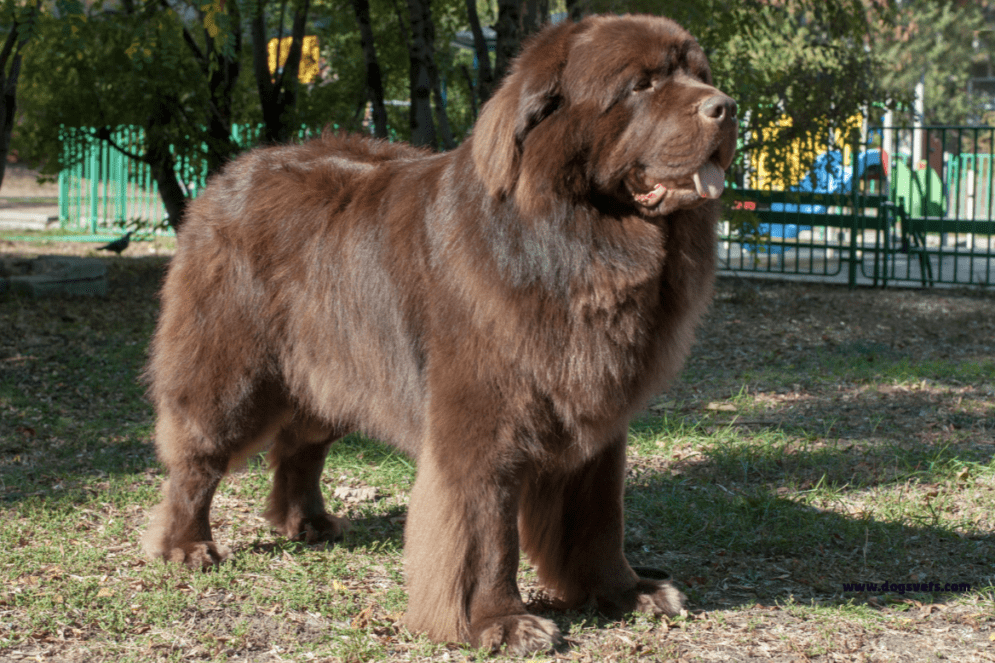
The Newfoundland Dog, affectionately known as the “Newfie,” is a large and powerful breed with a gentle disposition, making them wonderful companions for families and individuals alike.
Hailing from the Canadian province of Newfoundland, these dogs were originally bred to assist fishermen by hauling nets, rescuing overboard crew members, and performing various tasks on land and in water.
Their exceptional swimming abilities and natural lifesaving instincts make them an iconic water rescue breed.
Despite their imposing size, Newfoundlands are known for their sweet and gentle nature, often referred to as “gentle giants.” They are excellent with children and display a patient and protective demeanor towards their family members.
Their loyalty and devotion make them superb companions, and their calm temperament makes them adaptable to various living situations.
Newfoundlands are a working breed and require regular exercise to maintain their health and happiness.
Daily walks and swimming sessions, if possible, are ideal activities for these dogs, as they love being in the water. However, their exercise requirements are moderate compared to other breeds of their size.
Grooming a Newfoundland can be quite involved, as their thick double coats require regular brushing to prevent matting and shedding.
Additionally, it’s essential to trim their nails and check their ears regularly to ensure good overall hygiene. This breed can be prone to certain health issues, such as hip dysplasia, elbow dysplasia, and heart conditions, so regular veterinary check-ups are crucial for maintaining their health.
Training a Newfoundland can be a rewarding experience, as they are intelligent and eager to please. Early training and socialization are essential to ensure they grow up to be well-behaved and obedient companions.
Consistent, positive reinforcement training methods will yield the best results, and establishing a strong bond between you and your dog from an early age is crucial.
#12. Bullmastiff

The Bullmastiff is a large, powerful breed known for its impressive size, gentle temperament, and unwavering loyalty.
Originally bred in England for guarding estates and game preserves, Bullmastiffs have evolved into loving and affectionate companions, perfect for families or individuals seeking a calm and easygoing pet.
Despite their imposing appearance, Bullmastiffs are known for their gentle and affectionate nature. They are excellent with children, forming strong bonds and displaying a protective instinct towards their family members.
Their loyalty and devotion make them exceptional watchdogs, and their size alone can be an effective deterrent for potential intruders.
One of the most appealing aspects of the Bullmastiff breed is their relatively low energy levels. They are content to spend much of their day lounging around the house and require minimal exercise compared to other breeds of their size.
A daily walk and some playtime are typically sufficient to keep a Bullmastiff healthy and happy.
Grooming a Bullmastiff is relatively low-maintenance, as their short coats require minimal brushing.
However, it’s essential to keep their wrinkles and skin folds clean to prevent infections and irritation. This breed can be prone to certain health issues, such as hip dysplasia, elbow dysplasia, and bloat, so regular veterinary check-ups are crucial for maintaining their health.
Training a Bullmastiff can be both rewarding and challenging. Due to their size and strength, early training and socialization are essential to ensure they grow up to be well-behaved and obedient companions.
Consistent, positive reinforcement training methods will yield the best results, and establishing a strong bond between you and your dog from an early age is crucial.
#13. Chinese Shar-Pei

The Chinese Shar-Pei is a medium-sized breed known for its distinctive wrinkled skin, loose folds, and blue-black tongue.
Originating from China, these dogs were initially bred for hunting, herding, and guarding. Over time, the Shar-Pei has evolved into a loving and loyal companion that enjoys spending time with its human family.
One of the most striking features of the Chinese Shar-Pei is its unique appearance.
The breed’s characteristic wrinkles and folds are not only adorable but also serve as a symbol of its rich history. While the wrinkles are most pronounced in puppies, they become less prominent as the dog matures.
Chinese Shar-Peis are intelligent, independent, and often described as having a “cat-like” demeanor. They can be reserved around strangers but form strong bonds with their families, making them excellent watchdogs.
Early socialization is crucial for Shar-Peis to ensure they develop well-rounded personalities and are comfortable around new people and animals.
When it comes to exercise, the Chinese Shar-Pei requires moderate activity to maintain good health. A daily walk and some playtime in the backyard or at the park are typically sufficient to keep this breed happy and fit.
Grooming a Chinese Shar-Pei can be relatively low-maintenance, as their short coats require minimal brushing.
However, it’s essential to clean their skin folds regularly to prevent skin infections and irritation. This breed can be prone to certain health issues, such as hip dysplasia, entropion, and skin allergies, so routine veterinary care is crucial to ensure a long and healthy life.
Training a Chinese Shar-Pei can be both rewarding and challenging due to their independent nature. Consistent, positive reinforcement training methods will yield the best results, and early training will help establish a strong bond between you and your dog.
#14. Pekingese Dog

The Pekingese, also known as the “lion dog” or “Peke,” is a small, toy-sized breed with a rich history dating back to ancient China.
Originally bred as companions for Chinese nobility and royalty, Pekingese dogs are known for their regal appearance, distinctive flat faces, and luxurious long coats.
Despite their small size, these dogs are confident, dignified, and have a strong presence.
Pekingese dogs are affectionate and loyal companions that thrive on human interaction. They form strong bonds with their families and are known to be somewhat protective of their loved ones.
While they may be reserved around strangers, Pekingese dogs warm up to new people quickly once they feel comfortable.
One of the most appealing aspects of the Pekingese breed is their adaptability to various living situations. They are well-suited for apartment living due to their small size and low exercise requirements.
A few short walks and indoor play sessions are usually sufficient to keep a Pekingese happy and healthy.
Grooming is an essential part of Pekingese care, as their long coats require regular brushing to prevent matting and tangles.
It’s also crucial to clean their facial folds to avoid potential skin issues. As a brachycephalic breed, Pekingese dogs can be prone to breathing difficulties, so it’s essential to monitor them closely during hot weather and exercise.
Pekingese dogs can be strong-willed and independent, which may present some challenges during training. However, with patience, consistency, and positive reinforcement, these intelligent dogs can learn basic commands and even some tricks.
In conclusion, the Pekingese is a regal, affectionate, and adaptable breed that makes a wonderful companion for individuals and families alike.
Their unique appearance, rich history, and strong bond with their owners make them a truly special breed. By providing proper care, grooming, and attention, you’ll ensure that your Pekingese dog remains a loving and loyal friend for years to come.
#15. Boston Terrier

The Boston Terrier is a charming, small-sized dog breed known for its distinct “tuxedo” coat, friendly personality, and unwavering loyalty. These dogs are fantastic companions for people of all ages, including children, and are always eager to engage in playful antics.
Like all terriers, Boston Terriers are an energetic breed that enjoys being active. However, their mood and willingness to engage in outdoor activities can be heavily influenced by weather conditions.
In extreme heat or during a snowstorm, a Boston Terrier may share your reluctance to venture outside for a walk.
One of the best ways to entertain a Boston Terrier indoors or in your backyard is by playing fetch with a ball. This activity requires minimal effort on your part, as the dog will happily retrieve the toy and bring it right back to your hands.
It’s an excellent way to provide mental and physical stimulation for your pet without having to engage in strenuous activity yourself.
Despite their lively nature, Boston Terriers are also known for their adaptability. They can adjust to a more relaxed lifestyle if necessary, making them a suitable companion for those with limited mobility or living in smaller spaces such as apartments.
When considering a Boston Terrier as your companion, keep in mind their potential health concerns, such as brachycephalic syndrome and allergies.
Regular vet check-ups and appropriate care will help ensure your Boston Terrier remains healthy and happy throughout their life.
Conclusion
Finding the perfect canine companion to match your relaxed lifestyle doesn’t have to be a challenge. With these 15 lazy dog breeds, you’re sure to find the perfect low-energy pet to fit your needs.
Whether you’re seeking a large, protective dog like the Bullmastiff or a small, affectionate breed like the Pekingese, there’s a lazy dog breed waiting to join your calm and easygoing home.
Do your research, consider your living situation, and choose a dog that will be the perfect addition to your laid-back lifestyle.
Questions and answers
What factors should I consider when choosing a lazy dog breed?
When selecting a lazy dog breed, consider your living situation (e.g., house or apartment), available space, time commitment for grooming and care, compatibility with children or other pets, and any specific breed-related health concerns.
Are lazy dog breeds suitable for families with children?
Yes, many lazy dog breeds are gentle, patient, and tolerant, making them excellent choices for families with children. However, it’s essential to research each breed’s specific temperament and needs to ensure a good match for your family.
Do lazy dog breeds require regular exercise?
While lazy dog breeds generally require less exercise than more active breeds, they still need some form of physical activity to maintain their overall health. Short walks and moderate play sessions are usually sufficient for these low-energy dogs.
How do I ensure my lazy dog maintains a healthy weight?
Monitor your dog’s food intake, provide appropriate portions based on their size and activity level, and engage in regular exercise, even if it’s low-intensity. Consult with your veterinarian for personalized advice on maintaining a healthy weight for your specific breed.
Are lazy dog breeds suitable for first-time dog owners?
Many lazy dog breeds can be suitable for first-time dog owners due to their low-maintenance nature and easygoing temperament. However, it’s essential to research each breed’s specific needs and potential challenges to ensure a positive experience.
Do lazy dog breeds typically have any specific health concerns?
Each breed may have its own set of breed-specific health concerns. For example, larger breeds like the Great Dane may experience joint issues, while smaller breeds like the Pug may be prone to breathing difficulties. Always consult with a veterinarian and research each breed’s specific health concerns before making a decision.
Can lazy dog breeds be trained easily?
Lazy dog breeds can often be trained with patience and consistency, but some breeds may be more independent and require additional effort.
Engaging in positive reinforcement training methods and providing mental stimulation can help keep your low-energy dog engaged and responsive during training sessions.
References
- American Kennel Club (AKC) – The AKC is a reputable source for breed information, including temperament, exercise needs, and health concerns. Visit their breed pages for more details on each of the lazy dog breeds mentioned in this article: https://www.akc.org/dog-breeds/
- PetMD – PetMD offers a wealth of information on dog breeds, including health concerns, grooming needs, and exercise requirements. Explore their breed directory for additional insights: https://www.petmd.com/dog/breeds
- Vetstreet – Vetstreet is another excellent resource for learning about dog breeds, their characteristics, and care needs. Browse their breed profiles for more information: http://www.vetstreet.com/dogs/breeds
- DogTime – DogTime provides in-depth breed profiles, including information on their personalities, exercise needs, and compatibility with children and other pets. Check out their breed directory for more information: https://dogtime.com/dog-breeds
- The Spruce Pets – The Spruce Pets offers advice on pet care, including information on dog breeds and their specific needs. Explore their dog breed section for more insights: https://www.thesprucepets.com/dog-breeds-4162142
- Petfinder – Petfinder is an excellent resource for finding adoptable dogs in your area. If you’re interested in adopting a lazy dog breed, browse their available pets and find the perfect companion for your relaxed lifestyle: https://www.petfinder.com/
- ASPCA – The American Society for the Prevention of Cruelty to Animals (ASPCA) provides helpful resources on pet care, including dog breed information and tips on responsible pet ownership. Visit their website for more details: https://www.aspca.org/pet-care/dog-care
Remember to consult with a veterinarian for personalized advice on your dog’s specific needs, including diet, exercise, and potential health concerns.
Fact Check
We hope you enjoyed reading this article. What are your thoughts on the topic?
“At [Dogsvets.com], our goal is to bring you the most accurate and up-to-date information on all things pet-related.
If you have any additional insights or would like to advertise with us, don’t hesitate to get in touch.
If you notice any errors or discrepancies in our content, please let us know so we can correct them.
We welcome your feedback and encourage you to share this article with others.”


